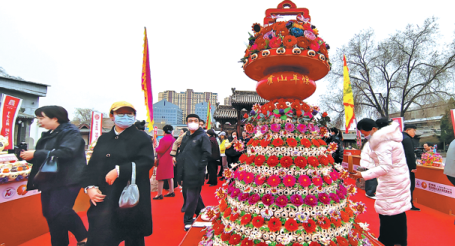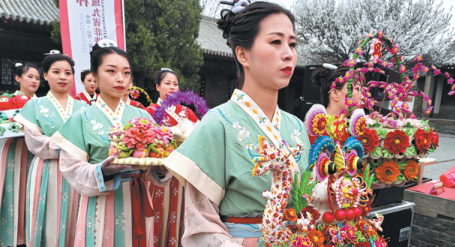Flowery buns showcase folk culture in Huozhou
Updated: 2023-03-31

A huge flowery bun on display in Huozhou. LIU JIANG/FOR CHINA DAILY
Masters of flowery buns from nine provinces and autonomous regions gathered in Shanxi's Huozhou city on March 16, to showcase how this ancient folk art converges and diversifies in various regions of China.
Flowery buns are a type of dough snack. They have been popular for many centuries in the Yellow River drainage basin, which includes regions such as Shanxi, Qinghai, Sichuan, Gansu, Ningxia, Inner Mongolia, Shaanxi, Henan and Shandong.
The special dough buns are called "flowery buns" due to their rich shapes and colors. Featuring auspicious decorations, the buns are mainly made and served during traditional Chinese festivals and family celebrations such as weddings and birthdays. They aim to bring fortune and good luck to the families.
In the Yellow River drainage basin, flowery buns are made with centuries-old techniques and the process is now on China's intangible cultural heritage list.
Despite their many similarities in origin and cultural connotations, flowery buns from different regions vary in style and content.
At the gathering, Su Xu, an inheritor of the Shanxi flowery bun, crafted his snacks in the shapes of Puju figures. Puju is a local opera popular in the southern Shanxi cities of Linfen and Yuncheng.
Han Xiang, an artist from Qinghai, showcased the snack's evolution as it spread westward to Qinghai. The buns he made are the most like cakes, wrapped with layers of fragrant condiments.
Zhang Kexin, acting mayor of Huozhou, attended the show. He told participants that Huozhou is a city renowned for its flowery buns.
He said the local Spring Festival bun, a variety of flowery buns, has been included in the intangible cultural heritage list in the city of Yuncheng. Huozhou, a part of Yuncheng, was also recognized as the "hometown of Spring Festival bun" by the China National Association of the Grain Sector in October 2022.
Zhang added that Huozhou's Spring Festival bun features the mixing of multiple ingredients, like doughs of wheat, corn, rice, soybean and other coarse cereals. Exploring the techniques of steaming, fermenting and sun-drying makes it possible for the buns to be preserved for a very long period.
"The longest preservation period can last several decades," he said.
In Huozhou, the Spring Festival buns have developed into an industry with a considerable scale.
Zhang said there are more than 120 factories and mills engaged in the sector, offering more than 5,000 jobs to local residents.
Liu Jiang contributed to this story.

Women staff members don traditional dress to present flowery buns at a fair in Huozhou. LIU JIANG/FOR CHINA DAILY



